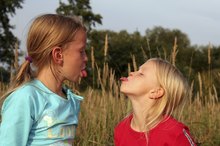Behavior Management Strategies for Children
Behavior management is the use of techniques to change or eliminate unwanted behavior and to encourage desirable behavior. Mental health professionals, teachers, youth service workers and parents all use behavior-management strategies. Adults may use different behavior management strategies at different times and for different children 2. The common ingredients are consistency, consequences and rewards.
Ignore to Instruct
Children sometimes engage in attention-seeking behavior, such as repeated interruptions, silliness or misbehaving. The ignoring strategy involves not rewarding your child with the attention she seeks, but also praising the desired behavior, as in “thank you for letting me complete my telephone call.” The idea is to ignore the unwanted behavior, attend to something different and then provide your youngster with attention when she behaves appropriately, advises the NYU Child Study Center.
Head It Off
The Operant Conditioning Principles Used to Teach Someone to Ride a Bike
Learn More
Before your child loses control or ends up in meltdown mode, provide something interesting or spend time being attentive to him to redirect his attention from the problem behavior. This redirecting strategy require you to distract your child by offering an alternative to his behavior. Negotiations can redirect him by making him part of the solution. Choices and alternatives encourages cooperation.
- Before your child loses control or ends up in meltdown mode, provide something interesting or spend time being attentive to him to redirect his attention from the problem behavior.
Send Signals
Signaling involves using prompts to stop or start specific behaviors. Prompts may be verbal or nonverbal, and they may be secret signals between you and your child. A prompt is used to alert her when it is time to start a desired behavior, such as “We will leave in five minutes.” You can count to 10 to signal your youngster to stop an undesired behavior or use the secret gesture to signal her instead.
Positive Reinforcement
What Are the Techniques of the Total Transformation Program?
Learn More
Positive reinforcement requires that you catch your youngster engaged in a desired behavior so you can praise or reward him. For instance, “I like how you shared your book with your friends.” Be sure to keep your positive reinforcement real; your child will likely catch on if you are offering insincere praise. Positive reinforcement may include praise or rewards, such as a special outing.
Natural Consequences
The natural consequences strategy can teach your child not to repeat undesired behavior. Natural consequences can help her become more responsible. Refusing to help your child if she repeatedly forgets or behaves irresponsibility or inappropriately may teach her to behave differently next time.
Related Articles
References
- Ask Dr. Sears: 10 Techniques to Shape Children's Behavior
- Center for Early Education and Development: Addressing the Needs of Young Children who Engage in Challenging Behaviors
- Coon, D & Mitterer, JO. Introduction to Psychology: Gateways to Mind and Behavior. Belmont, CA: Wadsworth Cengage Learning; 2010.
- American Academy of Pediatrics. Positive reinforcement through rewards. Updated November 21, 2015.
- Scott HK, Cogburn M. Behavior modification. In: StatPearls [Internet]. Treasure Island (FL): StatPearls Publishing. Updated April 17, 2019.
- Coon, D & Mitterer, JO. Introduction to Psychology: Gateways to Mind and Behavior. Belmont, CA: Wadsworth Cengage Learning; 2010.
- Salkind, NJ & Rasmussen, K. Encyclopedia of Educational Psychology, Volume 1. Thousand Oaks, CA: SAGE Publications; 2008.
Writer Bio
Gail Sessoms, a grant writer and nonprofit consultant, writes about nonprofit, small business and personal finance issues. She volunteers as a court-appointed child advocate, has a background in social services and writes about issues important to families. Sessoms holds a Bachelor of Arts degree in liberal studies.









